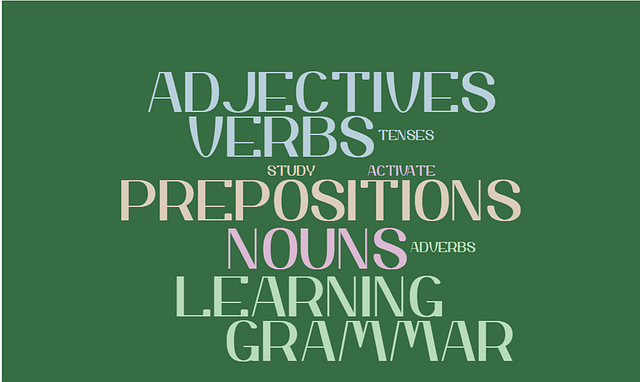language
المقررات الدراسية موسومة بـ "language"
Word Classes
Learn about word classes, identifying them and what they are. This course is ideal for intermediate learners.
Introduction
Identifying word classesWhen we identify what class a word belongs to, we may think about the following:
· The meaning of the word (for example, is it a ‘thing’ or a ‘doing’ word?)
· The form or ‘shape’ of the word (for example, does it have ‘ed’ or ‘tion’ at the end?)
· The position or ‘environment’ of the word in a sentence (the context).
Verbs are ‘action’ or ‘doing’ words. Verbs can take place in the following tenses, the verb used is the word ‘jump’.
· Past tense, for example “we jumped on the wall.”
· Present tense for example, “we jump on the wall.”
· Future tense for example, “we will jump on the wall.”
Nouns are naming words for people, places, things and ideas.
Nouns can be subdivided into different types:
1. Concrete nouns are objects we can smell, taste, touch and see such as chair, table and dog.
2. Abstract nouns are ideas, states and feelings such as, love, honour and hope.
3. Common nouns name types of people, places, things and ideas such as, winter, biscuit and city.
4. Proper nouns name specific people, places, things and ideas such as William Shakespeare, Cardiff and Batman.
Pronouns are words that replace nouns (the name of a person or an object) when it is already clear whom or what you are talking about.
For example:
Jane has broken her leg. She’ll not be able to play football today.
In the second sentence, she means Jane.
You will learn
- Word classes
- Identifying word classes
- Verbs
- Nouns and pronouns
- Adjectives
- Adverbs
- Prepositions
- Conjunctions
Verbs and adverbs
Learn about verbs and adverbs, what they are, how to use a verb in a sentence and how to use an adverb with a verb. This course is ideal for intermediate learners.
Introduction
In this course we are going to think about what verbs and adverbs are, and the different ways that we might use these words in everyday sentences.In English there are different types of words that we use to make up our sentences – verbs and adverbs are two of these word types.
There are another two word types that you will be able to find in most sentences and these are nouns and adjectives (we look at these in more detail in another session).
Each word type performs a specific job or role in any given sentence.
Every sentence in the English language has to have a verb in it – without a verb, it is not a proper or complete sentence, which just goes to show how important these words really are.
The reason they are so important is because they explain the action of a sentence. From the verb we know exactly what any given person is doing – whether it is a physical action or whether they are simply thinking about something.
You will learn
By the end of this session, you will:· Know what a verb is
· Understand how to use a verb in a sentence
· Know what an adverb is, and
· Understand how to use an adverb with a verb
Proofreading with SPAG
Learn about proofreading with SPAG, what is meant by this, how to use SPAG as part of your proofreading and how to write your own proofreading checklist. This course is ideal for intermediate learners.
Introduction
In this session we are going to look at the different ways you might proofread, or check through, different parts of your written work.Proofreading is when you read back over a document that you have written – such as a letter or an essay, for example – and you double check that everything is written and punctuated correctly.
Most people will proofread their work multiple times, each time looking for separate things.
· The first time you read your work you might be checking your spelling – is everything spelt correctly?
· The second time you read through your work you might be checking your tenses – is everything written in the right tense? Is everything written in the same tense? And so on.
The main reason for proofreading your work is to check that what you have written is of the best quality that it can possibly be. Here are examples of what proofreading, again and again, can help check for.
· The order we have written things in – does it make sense or could it have a better flow? Does it sound well thought-out or does it sound more like we got distracted halfway through?
· The way we have written things – if we have handwritten our work then this might be a case of checking whether our writing is clear for someone else to read; this point might also encourage us to look at how we have phrased things and whether our meaning is coming across.
· Whether there are any mistakes – checking for mistakes is especially important as not only does this affect how clear your work is but it can also affect how professional your work looks as well.
You will learn
· Understand what is meant by proofreading· Understand what is meant by SPAG
· Know how to use SPAG as part of your proofreading
· Know how to write your own proofreading checklist
Prepositions, conjunctions and articles
Learn about prepositions, conjunctions and articles, what prepositions and conjunctions are, how prepositions are used and when to use a conjunction and a number of different articles. This course is ideal for intermediate learners.
Introduction
Prepositions are a type of word that have one or two different uses in the English language. In fact, we use prepositions so often in our speech and our writing that they are thought to be some of the most common words in English.
A preposition is a word – or sometimes a phrase – that is used to explain where something is or when something is happening/will happen in relation to something else.
When we look at some example sentences you might be surprised to see just how many words count as a prepositions. You will probably recognise most of them!
You will learn
- Know what a preposition is
- Understand how prepositions are used
- Know what a conjunction is
- Understand when to use a conjunction
- Know a number of different articles
Metaphors and Similes
Learn about metaphors and similes, what figurative language is, what a metaphor and simile is and how and when we use them. This course is ideal for intermediate learners.
Introduction
In this course we are going to look at what metaphors and similes are, and how we might use them as part of writing.
Metaphors and similes are both examples of figurative language – this is an umbrella term that covers lots of different writing techniques in English.Not only does figurative language include metaphors and similes but it also includes things like hyperbole (when you deliberately exaggerate something) and onomatopoeia (which is when a word sounds like the thing that it is describing).
The reason it is called figurative language is because these different writing styles are not to be taken literally – meaning they work through associations and imagery, rather than saying things how they really are.
You will learn
- Understand what figurative language is
- Know what a metaphor is
- Know what a simile is
- Understand how and when we use metaphors and similes
Homonyms
Learn about homonyms, what homonyms and homophones are, the difference between them and the most common homonyms in English. This course is ideal for intermediate learners.
Introduction
In this course we are going to look at the meaning of the word homonym and take a closer look at some words that fall into this language family.
In the English language homonyms are a family of words that sound the same or similar to each other, but they have completely different meanings.Homonyms is actually a big name that covers a few other types of words as well, such as:
· Homophones
· Homographs
· Heteronyms
Homophones are very common in English and there are lot of words – many of which we use on a daily basis – that fall into the homophone family.
Homophones are a type of homonym and the term is used to describe words that sound the same, or sound very similar to each other, but they have different meanings and different spellings.
If we say where (W H E R E) and wear (W E A R) aloud it is easy to spot that these words sound exactly the same as each other – even though they have different spellings and different meanings.
You will learn
- Understand what homonyms are
- Understand what homophones are
- Know the difference between homonyms and homophes
- Know several of the most common homonyms in English
Adjectives
Learn about adjectives, what it is, what a comparative and superlative adjectives are and when to use different types of adjectives. This course is ideal for intermediate learners.
Introdcution
In the English language there are different word types that we use to make up our sentences. Examples of these word types are verbs (also known as doing words), adverbs (that add description to a verb), and nouns (which are things, a place, or a person).
Adjectives are another word type that we use on a day-to-day basis. One way to think of adjectives is as describing words, as they are typically used to describe a noun and give a reader or a listener more detail about something. Using words to build detail will make your descriptions even better and make your writing even more enjoyable for a reader.
You will learn
- Understand what an adjective is
- Understand what a comparative adjective is
- Understand what a superlative adjective is
- Know when to use different types of adjectives
Language Devices
This course will take you through the mnemonic ‘A RED FOREST’ which will help you understand and remember some of the most common language devices used.
Introduction
Language devices, otherwise known as literacy devices, refer to diverse structures used in effective writing to engage the audience. We often use language devices but do not always realise it. However, we need to know and understand these writing techniques to appreciate and interpret written text.When pronouncing the word ‘mnemonic’, the ‘m’ is not pronounced. It is silent.
It is a pattern of letters that assist us in remembering something, often associated with spelling.
We all remember being at school with the teacher getting us to spell ‘because’ don’t we?
If you are struggling, try using the mnemonic in this course !
You will learn
- Employing language devices
- What is a mnemonic?
- What is A RED FOREST?
- Examples of each language device










